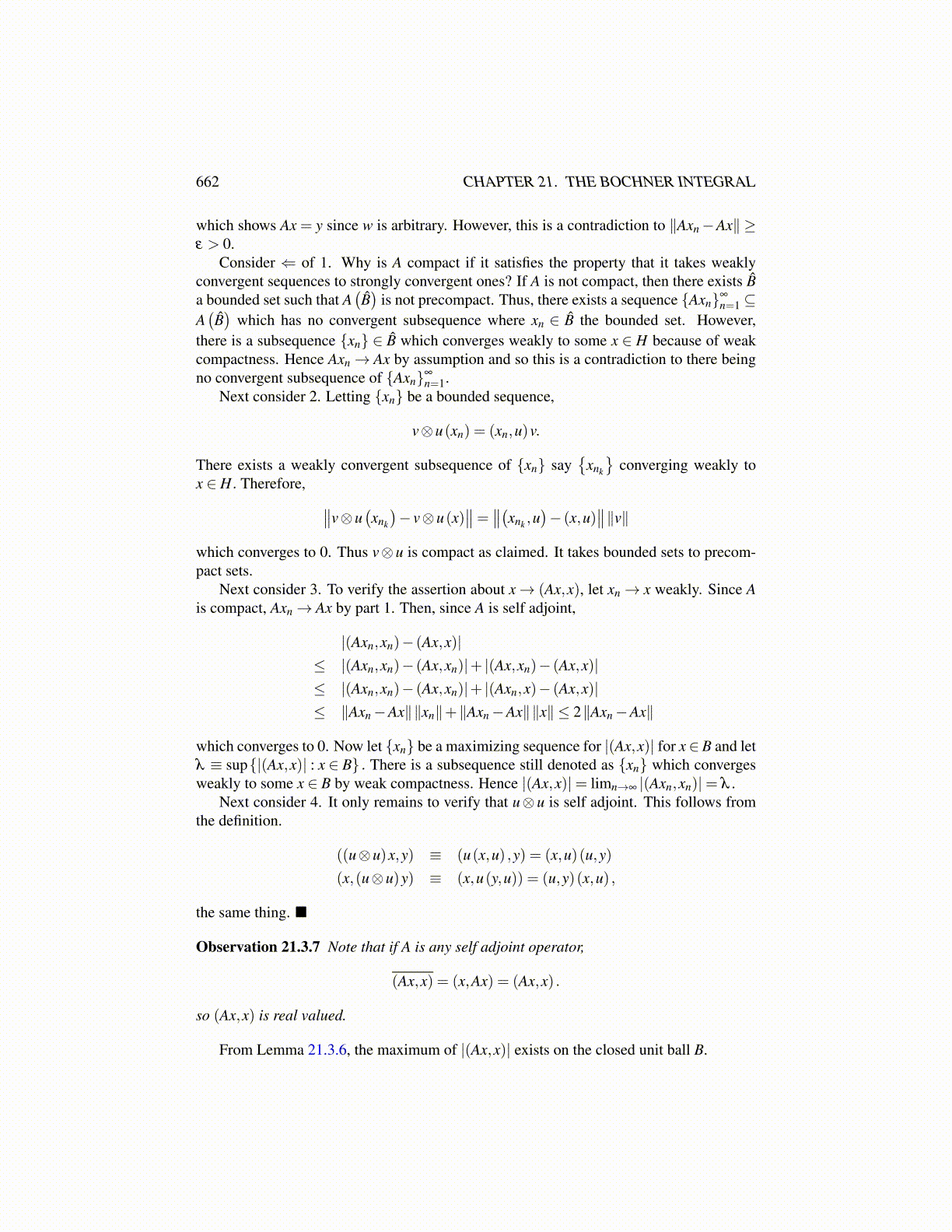
662 CHAPTER 21. THE BOCHNER INTEGRAL
which shows Ax = y since w is arbitrary. However, this is a contradiction to ∥Axn−Ax∥ ≥ε > 0.
Consider ⇐ of 1. Why is A compact if it satisfies the property that it takes weaklyconvergent sequences to strongly convergent ones? If A is not compact, then there exists B̂a bounded set such that A
(B̂)
is not precompact. Thus, there exists a sequence {Axn}∞
n=1 ⊆A(B̂)
which has no convergent subsequence where xn ∈ B̂ the bounded set. However,there is a subsequence {xn} ∈ B̂ which converges weakly to some x ∈ H because of weakcompactness. Hence Axn→ Ax by assumption and so this is a contradiction to there beingno convergent subsequence of {Axn}∞
n=1.Next consider 2. Letting {xn} be a bounded sequence,
v⊗u(xn) = (xn,u)v.
There exists a weakly convergent subsequence of {xn} say{
xnk
}converging weakly to
x ∈ H. Therefore, ∥∥v⊗u(xnk
)− v⊗u(x)
∥∥= ∥∥(xnk ,u)− (x,u)
∥∥∥v∥which converges to 0. Thus v⊗u is compact as claimed. It takes bounded sets to precom-pact sets.
Next consider 3. To verify the assertion about x→ (Ax,x), let xn→ x weakly. Since Ais compact, Axn→ Ax by part 1. Then, since A is self adjoint,
|(Axn,xn)− (Ax,x)|≤ |(Axn,xn)− (Ax,xn)|+ |(Ax,xn)− (Ax,x)|≤ |(Axn,xn)− (Ax,xn)|+ |(Axn,x)− (Ax,x)|≤ ∥Axn−Ax∥∥xn∥+∥Axn−Ax∥∥x∥ ≤ 2∥Axn−Ax∥
which converges to 0. Now let {xn} be a maximizing sequence for |(Ax,x)| for x∈ B and letλ ≡ sup{|(Ax,x)| : x ∈ B} . There is a subsequence still denoted as {xn} which convergesweakly to some x ∈ B by weak compactness. Hence |(Ax,x)|= limn→∞ |(Axn,xn)|= λ .
Next consider 4. It only remains to verify that u⊗u is self adjoint. This follows fromthe definition.
((u⊗u)x,y) ≡ (u(x,u) ,y) = (x,u)(u,y)
(x,(u⊗u)y) ≡ (x,u(y,u)) = (u,y)(x,u) ,
the same thing.
Observation 21.3.7 Note that if A is any self adjoint operator,
(Ax,x) = (x,Ax) = (Ax,x) .
so (Ax,x) is real valued.
From Lemma 21.3.6, the maximum of |(Ax,x)| exists on the closed unit ball B.